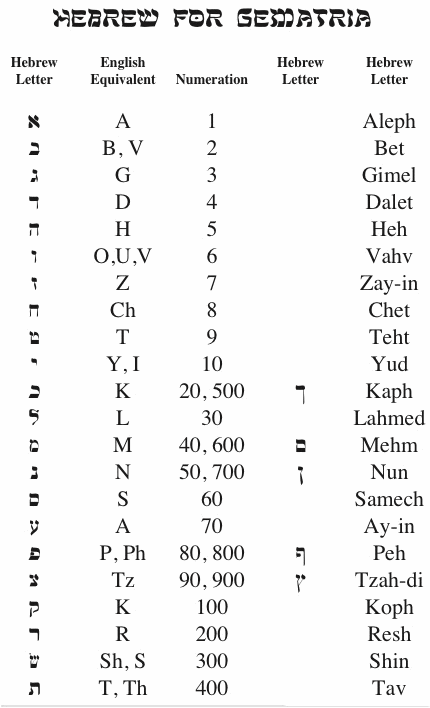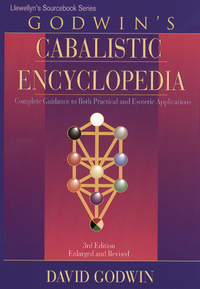On Gematria
One of the most popular and successful aspects of working magick involves what is known as Gematria (pronounced with a hard G as in “good”: gem-ei-tree-uh). Gematria is a Kabalistic technique for taking the letters of Hebrew (and later other languages) and assigning them a numerical value. It is believed that if two words had the same numerical total they had a significant relationship to each other, and in some cases could be considered synonyms. As an example, aheva = 13 and echod = 13. Therefore, aheva is the same as echod. Echod is the Hebrew word meaning “one.” Since in Judaism there is only one God, it also represents God. Aheva is Hebrew for “love.” Therefore, according to this system, God is love. Further, the holiest name of God, the Tetragrammaton of YHVH totals 26. Since 13+13= 26, we can say that love (aheva) plus oneness (echod) equals the nature of God (YHVH). Here is a chart I designed for Modern Magick: Other than proving things such as God is Love, gematria is far more than a mental exercise. Although gematria is invaluable for learning secret meanings of words and symbols (such as on Tarot cards), it’s also a fundamental technique in many forms of magick. Sure it can be useful in the evocation of spirits (I’ll leave that to another post), but perhaps its most important function is as a key tool for creating new and unique correspondences for use in forms of sympathetic magick. Using gematria you can come up with a number (or another word that equals this number) and use it as a correspondence to empower your magick and make it more effective.
Other than proving things such as God is Love, gematria is far more than a mental exercise. Although gematria is invaluable for learning secret meanings of words and symbols (such as on Tarot cards), it’s also a fundamental technique in many forms of magick. Sure it can be useful in the evocation of spirits (I’ll leave that to another post), but perhaps its most important function is as a key tool for creating new and unique correspondences for use in forms of sympathetic magick. Using gematria you can come up with a number (or another word that equals this number) and use it as a correspondence to empower your magick and make it more effective.
For example, if you wanted more love, you could inscribe or write the number 13 (as described above) on the object—ranging from a simple doll (or poppet) to a complex talisman—you’ll use for your magick. Alternatively, you could transliterate from English using the chart above. L=30, O=6, V=6* and E, being silent, gets no attribution. Thus, “love” could = 30+6+6 or 42 (hmm, Douglas Adams might have liked that). You could also use a mystical formula such as 13=42 and make perfect sense.
But what if, instead of a number, you wanted to use a word or phrase linked to that number? If you’re unfamiliar with the language, how do you make up words in Hebrew that total 13? And how do you figure out words in English that total your number? (Well, 42 could be pronounced “Mob”—if you don’t count the vowel—so perhaps you want to be “Mobbed with love?”)
If all you wanted to use, for example, were words from the Hebrew Torah (the first five books of the Bible), there’s a book for that. However, magicians usually prefer something far more specialized. Aleister Crowley first published a study like this with his book, Sepher Sephiroth. Using our 13 example, he gives fourteen words with a gematria value of 13. Since one of those words is a locust, you could use a drawing of a grasshopper to represent love.
For an easier-to-use and more complete book with gematria relationships and other associated techniques and information, the book Godwin’s Cabalistic Encyclopedia by David Godwin is an ideal resource. It even includes Crowley’s Sepher Sephiroth.  As you become more involved with the use of gematria for theory and practice, you may find your own lists of gematria will be getting bigger to a point where, well, they’re really out of hand. What’s needed, in my opinion, is something where you can easily jump from one thing to another and find terms, meanings, translations, transliterations, and more. This is something that simply cannot be done in a book format, but can be done electronically. And I’m glad to say that some friends of mine have done exactly that.
As you become more involved with the use of gematria for theory and practice, you may find your own lists of gematria will be getting bigger to a point where, well, they’re really out of hand. What’s needed, in my opinion, is something where you can easily jump from one thing to another and find terms, meanings, translations, transliterations, and more. This is something that simply cannot be done in a book format, but can be done electronically. And I’m glad to say that some friends of mine have done exactly that.
A New Tool for
Students of Gematria
In a pdf format, the people at Thelesis Aura have published Cartier’s Dictionary of Gematria by François Cartier, a student of the Hermetic Qabalah for 45 years. It’s the most complete and massive cross-reference of gematria I’ve ever seen. Because it’s electronic it’s easy to use and a must for magicians. A massive 539 digital pages, the numerical relationships between key words in Hebrew, Latin, and Greek are connected through an elaborate system of internal hyperlinks with explanations in English, combined with extensive tables, indexes, and interactive graphics. Looking again at the gematria equivalents associated with the number 13, there are an astounding 43 associations, plus information on key concepts related to the number, arithmetic associated with the number, geometry associated with 13 (including that it’s the sum of the faces and edges in a regular pyramid, making this number associated with pyramids and their correspondences), the Tree of Life, and more. The appendices include selections from Fabre d’Olivet’s The Hebraic Tongue Restored, Gesenius’ Hebrew and Chaldee Lexicon to the Old Testament Scriptures, Strong’s Exhaustive Concordance of the Bible, Paul Foster Case’s Gematria, and Aleister Crowley’s Gematria.
I don’t see this as competition for books such as Sepher Sephiroth or Godwin’s Cabalistic Encyclopedia so much as a valuable complement to them. The more information you have from these tools, the better a magician you’ll be.
One thing to be aware of: This is a highly technical file from a computer standpoint. I tried to open the pdf file with a simple reader and it wouldn’t do it. I would suggest that you get the latest Adobe Reader (it’s free) directly from Adobe. The current version is XI, although this .PDF has been tested to run under version X, too. The link to this ebook opens to a page that has a link to Adobe’s website so you can download the reader.
* Alert readers will note there are two Hebrew letters and associated numbers that carry the sound “B.” There are also sounds in English that are missing or have duplicate Hebrew letters. As a general rule, if there is no direct comparison in Hebrew, work something similar. For example, the English “C” can be sound like an “S” or a “K.” Use Hebrew letters associated with those sounds in place of the “C.” Although in pure Hebrew there are specific rules for choosing which letter to use when a word might have to letters with the same sound, these rules are generally not followed in this type of Gematria. Try using each and see which one provides the most significance to your investigations.








“Gematria is a Kabalistic technique for taking the letters of Hebrew (and later other languages)”
Actually Gematria was developed heavily by the Greeks and later was adopted by the Jewish Mystics.